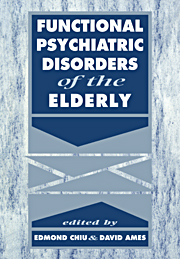Book contents
- Frontmatter
- Contents
- List of contributors
- Preface
- Introduction – A personal note
- Acknowledgement
- Part 1 Classification
- Part 2 General epidemiology
- Part 3 Neuroses
- Part 4 Affective disorders
- Part 5 Psychosexual disorders
- Part 6 Substance use and abuse
- Part 7 Schizophrenia and related psychoses
- Part 8 Psychological, biological and medical issues
- Part 9 Treatment methods
- 25 Geriatric psychopharmacology
- 26 Electroconvulsive therapy in later life
- 27 Family therapy
- 28 Group therapy in the elderly
- 29 Integrated psychotherapy of the elderly
- 30 Management of the treatment team in a multidisciplinary framework
- 31 Occupational therapy
- 32 Nursing management
- 33 Social work and the psychiatry of late life
- 34 Music therapy
- 35 Physiotherapy
- Part 10 Conclusion
- Index
26 - Electroconvulsive therapy in later life
from Part 9 - Treatment methods
Published online by Cambridge University Press: 13 November 2009
- Frontmatter
- Contents
- List of contributors
- Preface
- Introduction – A personal note
- Acknowledgement
- Part 1 Classification
- Part 2 General epidemiology
- Part 3 Neuroses
- Part 4 Affective disorders
- Part 5 Psychosexual disorders
- Part 6 Substance use and abuse
- Part 7 Schizophrenia and related psychoses
- Part 8 Psychological, biological and medical issues
- Part 9 Treatment methods
- 25 Geriatric psychopharmacology
- 26 Electroconvulsive therapy in later life
- 27 Family therapy
- 28 Group therapy in the elderly
- 29 Integrated psychotherapy of the elderly
- 30 Management of the treatment team in a multidisciplinary framework
- 31 Occupational therapy
- 32 Nursing management
- 33 Social work and the psychiatry of late life
- 34 Music therapy
- 35 Physiotherapy
- Part 10 Conclusion
- Index
Summary
Electroconvulsive therapy (ECT) is not contraindicated by advanced age. Indeed, over the years a number of studies have reported a more favorable treatment response in elderly people (Gold & Chiarella, 1944; Hobson, 1953; Roberts, 1959; Mendels, 1967; Coryell & Zimmerman, 1984). Reviewers have concluded, modestly, that elderly people respond to ECT at least as well as younger people (Weiner, 1982; Benbow, 1989). There are, however, particular areas of concern for clinicians who prescribe ECT for elderly people: concurrent physical illness is often present, and possible side-effects may worry doctor, relatives and patient.
This chapter will cover the following areas:
Indications for ECT in late life.
Safety of ECT.
Side-effects of ECT in the elderly.
Efficacy.
Treatment resistant depression, ECT and maintenance ECT.
Consent.
Practical aspects of treating older people with ECT.
Indications for ECT in late life
The American Psychiatric Association Task Force Report (1990) lists the main indications for ECT as major depression, mania and schizophrenia and other functional psychoses. In the elderly, depressive illness is the main indication for ECT (Fraser, 1981), but views vary regarding the place of this treatment in the modern therapeutic armoury.There is now a wider selection of drugs available and some authors argue that ECT should be a treatment of last resort (Malcolm & Peet, 1989). The opposing view is that elderly people may be placed ‘in jeopardy’ have to be treated with antidepressant drugs before receiving ECT (Weiss & Weiss, 1987).
- Type
- Chapter
- Information
- Functional Psychiatric Disorders of the Elderly , pp. 440 - 460Publisher: Cambridge University PressPrint publication year: 1994
- 3
- Cited by



